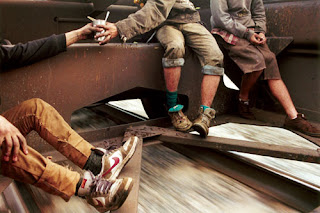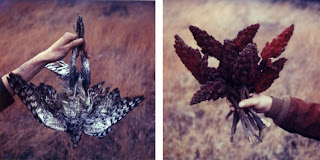
Sometimes it seems like Mike Brodie takes all his photos at the golden hour when everything is enhanced by the reddish light of the setting sun. How else could the most mundane, the most gritty, be so luscious, so attractive? Why else would I too want to be there, on the edge of the—what is it?—boxcar?—perched on the iron ledge just a few feet from the gravel and rails. It's that, the golden rays of the sun, or else his gaze which does it. His photos are so intimate, close in, right in there, one with the scene played out. The communal sharing—one can of beans (it must be beans, right?) between them all—is at the heart of his work. The camera does not get between him and the others, so the frankness of his picture-taking is not on the sly, nor "objective," but friendly-like, welcomed. Look at this girl, her poise. And he's going to get right down there with her, you know it.

And then there's the detail of the grime, the naked feet, her feet, the other foot, the torn mattress on a pile of rebar in the bed of a metal box car, the softness of her flesh, the golden skin—this feral child, wild and beautiful.

When he was younger (you know, like a
baby) he started taking photos with a Polaroid camera. (The recent work is 35 mm.) Polaroids are just beautiful in and of themselves: the size, the coloration, the filminess. It was a perfect immediate, tactile, almost ephemeral medium for his milieu—on the road, ridin' rails, living in the woods.
Hawk and
Sumac were shot in a shantytown in Maine. They are part of a wonderful small photo book put out by
These Birds Walk art books in Oakland CA.

Brodie is in love with his golden world, his train-hoppin' hobo friends, and that's what works. In every flock of wild child-s there's at least one who makes good, who, come Fall, let alone Winter, won't be caught seeking shelter under a bridge. Golden and free, and
movin' on.
Mike Brodie won the 2008 Baum Award for Emerging American Photographers. Selected out of a running of 50 young photographers, Brodie shows some of his photos from
Boys and Girls of Modern Days Railways at
SF Camerawork in his award exhibition. The award says it: this boy's good. He takes the cake. Yeah.
Pics courtesy of SF Camerawork and one of my all-time favorite galleries in LA which introduced me to Brodie's work in 2005—right on—
M+B Gallery.








